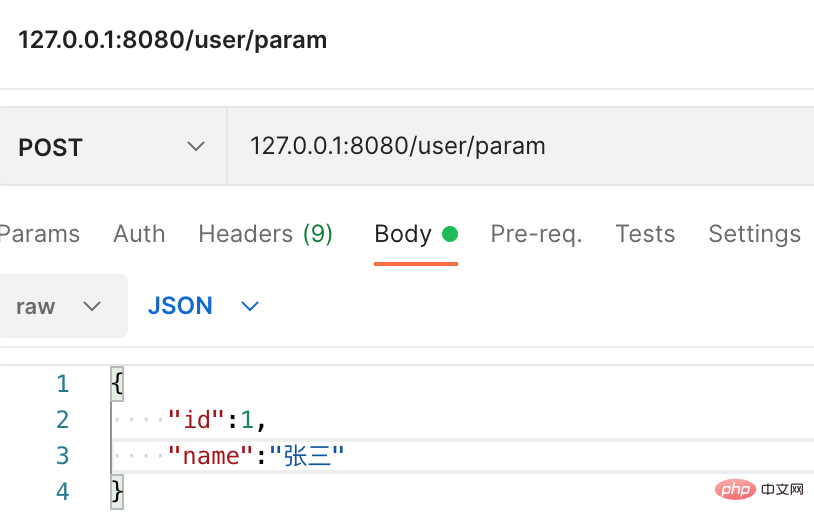Springboot は spel と aop を組み合わせて使用し、動的なパラメータ転送を実現します
SpEl 式の概要
コードを書き始める前に、まず Spring フレームワークの強力なツールである SpEl (Spring Expression Language) 式について理解しましょう。実行時に複雑な式を構築し、オブジェクトのプロパティにアクセスし、オブジェクトのメソッドを呼び出すなどの SpEl
理解を容易にするために、次のような簡単な例を示します
//定义了一个表达式 String expressionStr = "1+1"; ExpressionParser parser = new SpelExpressionParser(); Expression expression = parser.parseExpression(expressionStr); Integer val = expression.getValue(Integer.class); System.out.println(expressionStr + "的结果是:" + val);
上記のケースを通して、それはそうではありません理解するのが難しいですが、いわゆる SpEl は本質的には解析式です。
SpEl 式に興味がある場合は、自分で情報を確認してください。この記事では詳しく説明しません。
例: SpEl と AOP 動的送信の組み合わせ 参考文献
SpEl 式を簡単に理解してから、直接コーディングを開始します。
まず、必要な pom 依存関係を紹介します。 aop 依存関係のみであり、SpEl 自体は Spring によってサポートされているため、追加の導入は必要ありません。
<dependency>
<groupId>org.springframework.boot</groupId>
<artifactId>spring-boot-starter-aop</artifactId>
</dependency>SpEl ツール クラスを定義します。SpelUtil
public class SpelUtil {
/**
* 用于SpEL表达式解析.
*/
private static final SpelExpressionParser parser = new SpelExpressionParser();
/**
* 用于获取方法参数定义名字.
*/
private static final DefaultParameterNameDiscoverer nameDiscoverer = new DefaultParameterNameDiscoverer();
/**
* 解析SpEL表达式
*
* @param spELStr
* @param joinPoint
* @return
*/
public static String generateKeyBySpEL(String spELStr, ProceedingJoinPoint joinPoint) {
// 通过joinPoint获取被注解方法
MethodSignature methodSignature = (MethodSignature) joinPoint.getSignature();
Method method = methodSignature.getMethod();
// 使用Spring的DefaultParameterNameDiscoverer获取方法形参名数组
String[] paramNames = nameDiscoverer.getParameterNames(method);
// 解析过后的Spring表达式对象
Expression expression = parser.parseExpression(spELStr);
// Spring的表达式上下文对象
EvaluationContext context = new StandardEvaluationContext();
// 通过joinPoint获取被注解方法的形参
Object[] args = joinPoint.getArgs();
// 给上下文赋值
for (int i = 0; i < args.length; i++) {
context.setVariable(paramNames[i], args[i]);
}
// 表达式从上下文中计算出实际参数值
/*如:
@annotation(key="#user.name")
method(User user)
那么就可以解析出方法形参的某属性值,return “xiaoming”;
*/
return expression.getValue(context).toString();
}
}パラメータベースのアノテーションを定義します。SpelGetParm
@Target({ElementType.METHOD, ElementType.TYPE})
@Retention(RetentionPolicy.RUNTIME)
public @interface SpelGetParm {
String parm() default "";
}パラメータベースのアノテーションを定義する SpelGetParmAop
@Aspect
@Slf4j
@Component
public class SpelGetParmAop {
@PostConstruct
public void init() {
log.info("SpelGetParm init ......");
}
/**
* 拦截加了SpelGetParm注解的方法请求
*
* @param joinPoint
* @param spelGetParm
* @return
* @throws Throwable
*/
@Around("@annotation(spelGetParm)")
public Object beforeInvoce(ProceedingJoinPoint joinPoint, SpelGetParm spelGetParm) throws Throwable {
Object result = null;
// 方法名
String methodName = joinPoint.getSignature().getName();
//获取动态参数
String parm = SpelUtil.generateKeyBySpEL(spelGetParm.parm(), joinPoint);
log.info("spel获取动态aop参数: {}", parm);
try {
log.info("执行目标方法: {} ==>>开始......", methodName);
result = joinPoint.proceed();
log.info("执行目标方法: {} ==>>结束......", methodName);
// 返回通知
log.info("目标方法 " + methodName + " 执行结果 " + result);
} finally {
}
// 后置通知
log.info("目标方法 " + methodName + " 结束");
return result;
}このケースのコア機能は基本的に上記で実装されています。次に、このアノテーションを使用してエンティティ User
@Getter
@Setter
@NoArgsConstructor
@JsonSerialize
@JsonInclude(Include.NON_NULL)
public class User implements Serializable {
private static final long serialVersionUID = -7229987827039544092L;
private String name;
private Long id;
}を定義できます。このアノテーションを UserController のパラメーターで直接使用すると、
@CrossOrigin
@RestController
@RequestMapping("/user")
public class UserController {
@PostMapping("/param")
@SpelGetParm(parm = "#user.name")
public R repeat(@RequestBody User user) {
return R.success(user);
}
}Last request

以上がSpringboot は spel と aop を組み合わせて使用し、動的なパラメータ転送を実現しますの詳細内容です。詳細については、PHP 中国語 Web サイトの他の関連記事を参照してください。

ホットAIツール

Undresser.AI Undress
リアルなヌード写真を作成する AI 搭載アプリ

AI Clothes Remover
写真から衣服を削除するオンライン AI ツール。

Undress AI Tool
脱衣画像を無料で

Clothoff.io
AI衣類リムーバー

AI Hentai Generator
AIヘンタイを無料で生成します。

人気の記事

ホットツール

メモ帳++7.3.1
使いやすく無料のコードエディター

SublimeText3 中国語版
中国語版、とても使いやすい

ゼンドスタジオ 13.0.1
強力な PHP 統合開発環境

ドリームウィーバー CS6
ビジュアル Web 開発ツール

SublimeText3 Mac版
神レベルのコード編集ソフト(SublimeText3)

ホットトピック
 7569
7569
 15
15
 1386
1386
 52
52
 87
87
 11
11
 28
28
 107
107
 Springboot が Jasypt を統合して構成ファイルの暗号化を実装する方法
Jun 01, 2023 am 08:55 AM
Springboot が Jasypt を統合して構成ファイルの暗号化を実装する方法
Jun 01, 2023 am 08:55 AM
Jasypt の概要 Jasypt は、開発者が最小限の労力で基本的な暗号化機能を自分のプロジェクトに追加できる Java ライブラリであり、暗号化の仕組みを深く理解する必要はありません。一方向および双方向暗号化の高いセキュリティ。標準ベースの暗号化テクノロジー。パスワード、テキスト、数値、バイナリを暗号化します... Spring ベースのアプリケーション、オープン API への統合、JCE プロバイダーでの使用に適しています... 次の依存関係を追加します: com.github.ulisesbocchiojasypt-spring-boot-starter2. 1.1 Jasypt の特典はシステムのセキュリティを保護し、コードが漏洩した場合でもデータ ソースは保証されます。
 SpringBoot が Redisson を統合して遅延キューを実装する方法
May 30, 2023 pm 02:40 PM
SpringBoot が Redisson を統合して遅延キューを実装する方法
May 30, 2023 pm 02:40 PM
使用シナリオ 1. 注文は正常に行われましたが、支払いが 30 分以内に行われませんでした。支払いがタイムアウトになり、注文が自動的にキャンセルされました 2. 注文に署名があり、署名後 7 日間評価が行われませんでした。注文がタイムアウトして評価されない場合、システムはデフォルトでプラスの評価を設定します 3. 注文は正常に行われます。販売者が 5 分間注文を受け取らない場合、注文はキャンセルされます。 4. 配送がタイムアウトします。 SMS リマインダーをプッシュします... 遅延が長く、リアルタイム パフォーマンスが低いシナリオでは、タスク スケジュールを使用して定期的なポーリング処理を実行できます。例: xxl-job 今日は選択します
 Redis を使用して SpringBoot に分散ロックを実装する方法
Jun 03, 2023 am 08:16 AM
Redis を使用して SpringBoot に分散ロックを実装する方法
Jun 03, 2023 am 08:16 AM
1. Redis は分散ロックの原則を実装しており、分散ロックが必要な理由 分散ロックについて話す前に、分散ロックが必要な理由を説明する必要があります。分散ロックの反対はスタンドアロン ロックです。マルチスレッド プログラムを作成するとき、共有変数を同時に操作することによって引き起こされるデータの問題を回避します。通常、ロックを使用して共有変数を相互に除外し、データの正確性を確保します。共有変数の使用範囲は同じプロセス内です。共有リソースを同時に操作する必要があるプロセスが複数ある場合、どうすれば相互排他的になるのでしょうか?今日のビジネス アプリケーションは通常マイクロサービス アーキテクチャであり、これは 1 つのアプリケーションが複数のプロセスをデプロイすることも意味します。複数のプロセスが MySQL の同じレコード行を変更する必要がある場合、順序の乱れた操作によって引き起こされるダーティ データを避けるために、分散が必要です。今回導入するスタイルはロックされています。ポイントを獲得したい
 Springbootがjarパッケージにファイルを読み込んだ後にファイルにアクセスできない問題を解決する方法
Jun 03, 2023 pm 04:38 PM
Springbootがjarパッケージにファイルを読み込んだ後にファイルにアクセスできない問題を解決する方法
Jun 03, 2023 pm 04:38 PM
Springboot はファイルを読み取りますが、jar パッケージにパッケージ化した後、最新の開発にアクセスできません。jar パッケージにパッケージ化した後、Springboot がファイルを読み取れない状況があります。その理由は、パッケージ化後、ファイルの仮想パスが変更されるためです。は無効であり、ストリーム経由でのみアクセスできます。読み取ります。ファイルはリソースの下にあります publicvoidtest(){Listnames=newArrayList();InputStreamReaderread=null;try{ClassPathResourceresource=newClassPathResource("name.txt");Input
 SpringBootとSpringMVCの比較と差異分析
Dec 29, 2023 am 11:02 AM
SpringBootとSpringMVCの比較と差異分析
Dec 29, 2023 am 11:02 AM
SpringBoot と SpringMVC はどちらも Java 開発で一般的に使用されるフレームワークですが、それらの間には明らかな違いがいくつかあります。この記事では、これら 2 つのフレームワークの機能と使用法を調べ、その違いを比較します。まず、SpringBoot について学びましょう。 SpringBoot は、Spring フレームワークに基づいたアプリケーションの作成と展開を簡素化するために、Pivotal チームによって開発されました。スタンドアロンの実行可能ファイルを構築するための高速かつ軽量な方法を提供します。
 SQL ステートメントを使用せずに Springboot+Mybatis-plus を実装して複数のテーブルを追加する方法
Jun 02, 2023 am 11:07 AM
SQL ステートメントを使用せずに Springboot+Mybatis-plus を実装して複数のテーブルを追加する方法
Jun 02, 2023 am 11:07 AM
Springboot+Mybatis-plus が SQL ステートメントを使用して複数テーブルの追加操作を実行しない場合、私が遭遇した問題は、テスト環境で思考をシミュレートすることによって分解されます: パラメーターを含む BrandDTO オブジェクトを作成し、パラメーターをバックグラウンドに渡すことをシミュレートします。 Mybatis-plus で複数テーブルの操作を実行するのは非常に難しいことを理解してください。Mybatis-plus-join などのツールを使用しない場合は、対応する Mapper.xml ファイルを設定し、臭くて長い ResultMap を設定するだけです。対応する SQL ステートメントを記述します。この方法は面倒に見えますが、柔軟性が高く、次のことが可能です。
 SpringBoot が Redis をカスタマイズしてキャッシュのシリアル化を実装する方法
Jun 03, 2023 am 11:32 AM
SpringBoot が Redis をカスタマイズしてキャッシュのシリアル化を実装する方法
Jun 03, 2023 am 11:32 AM
1. RedisAPI のデフォルトのシリアル化メカニズムである RedisTemplate1.1 をカスタマイズします。API ベースの Redis キャッシュ実装では、データ キャッシュ操作に RedisTemplate テンプレートを使用します。ここで、RedisTemplate クラスを開いて、クラスのソース コード情報を表示します。publicclassRedisTemplateextendsRedisAccessorimplementsRedisOperations、BeanClassLoaderAware{//キーを宣言、値の各種シリアル化メソッド、初期値は空 @NullableprivateRedisSe
 Springbootでapplication.ymlの値を取得する方法
Jun 03, 2023 pm 06:43 PM
Springbootでapplication.ymlの値を取得する方法
Jun 03, 2023 pm 06:43 PM
プロジェクトでは、構成情報が必要になることがよくありますが、この情報はテスト環境と本番環境で構成が異なる場合があり、実際のビジネス状況に基づいて後で変更する必要がある場合があります。これらの構成をコードにハードコーディングすることはできません。構成ファイルに記述することをお勧めします。たとえば、この情報を application.yml ファイルに書き込むことができます。では、コード内でこのアドレスを取得または使用するにはどうすればよいでしょうか?方法は2つあります。方法 1: @Value アノテーションが付けられた ${key} を介して、構成ファイル (application.yml) 内のキーに対応する値を取得できます。この方法は、マイクロサービスが比較的少ない状況に適しています。方法 2: 実際には、プロジェクト、業務が複雑な場合、ロジック




